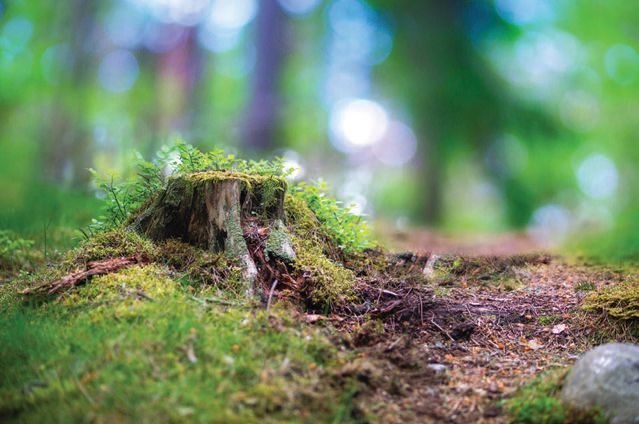Testing for biodegradability
R. David Whitby | TLT Worldwide September 2016
Measurements show different aspects and vary depending on the time of year.

Most materials are inherently biodegradable, in that they will decay over some period of time.
© Can Stock Photo Inc. / PinkBadger
BIODEGRADATION IS THE DECOMPOSITION OF MATERIALS BY BIOLOGICAL SYSTEMS, usually bacteria and fungi. Primary biodegradation is conversion into new products that (usually) do not have the same chemical properties as the material. Ultimate biodegradation is complete conversion into carbon dioxide, water, inorganic compounds and new biomass. Without biodegradation, the world’s landmasses would be covered hundreds of meters deep in dead animals and plants.
Aerobic biodegradation occurs in the presence of oxygen (e.g., the decay of dead trees). Anaerobic biodegradation occurs in the absence of oxygen (e.g., in the sludge at the bottom of a pond).
Readily and
inherently biodegradable products are classified according to the percentage loss of organic carbon, the amount of carbon dioxide produced and/or the oxygen required to achieve biodegradation. Most materials are inherently biodegradable, in that they will decay over some period of time. Dead trees can take years to decay. Readily biodegradable materials will decay quite quickly, over days or weeks. (Some materials are very hard to degrade and tend to bioaccumulate; this is much worse for the environment.)
The Organization for Economic Cooperation and Development (OECD) Guidelines for the Testing of Chemicals list seven different tests for determining the readily biodegradability of chemical compounds:
•
OECD 301 A: DOC (Dissolved Organic Carbon) Die-Away (AFNOR Test)
•
OECD 301 B: CO
2 (Carbon Dioxide) Evolution (Modified Sturm Test)
•
OECD 301 C: Modified MITI
•
OECD 301 D: Closed Bottle
•
OECD 301 E: Modified OECD Screening
•
OECD 301 F: Manometric Respirometry
•
OECD 310: CO
2 in Sealed Vessels (Headspace Test).
Another test, widely used in the oil industry is the CEC-L-33-A-93 test, which was originally developed to assess the biodegradability of two-stroke oils accidentally spilled on lakes but is now used to assess any oils accidentally spilled, whether on water or on soil.
These tests are intended to simulate biodegradation in a specific environment using indigenous biomass such as soil, sediment, activated sewage sludge or sludge water and a typical temperature that represents the particular environment. A low concentration of test substance is used. Temperatures are usually 20 C (68 F) or 25 C (77 F) and samples are shaken, stirred or air blown for either 14, 21 or 28 days. Measurements are made of either CO
2 produced, O
2 consumed or the Total Organic Carbon that remains.
The different tests are used to measure different aspects of biodegradability. Some are suitable for water-soluble materials, others for water-insoluble materials and others for volatile compounds. The European Chemicals Agency published guidelines on which tests should be used in specific circumstances and for specific types of substances. (See
http://echa.europa.eu/practical-guides.)
Unfortunately all the tests tend to give variable results, depending on the time of the year and the type and condition of the sewage sludge or soil used to
inoculate the test sample. This is because the concentration and health of the bacteria and fungi in the
inoculum varies depending on whether the season is wet or dry, how the sewage treatment works is being operated or where the soil samples were taken from. The inoculum also need to be kept alive using culture media. These have a tendency to favor some species of bacteria and fungi over others. The variation in results from the same test method done in different laboratories or at different times of the year in the same laboratory can be as much as ±10%.
Laboratories could try to use a
standard inoculum, specific to each test method, but this would still need to be cultured even if it was freeze dried. Also many thousands of packets of freeze-dried standard inocula would need to be prepared in a central laboratory to be shipped to test laboratories around the world. This monumental and expensive task would need to be repeated and recertified every few years, with few obvious benefits for the biodegradability tests.
I think we will have to learn to live with the range and variability of biodegradability tests.
 David Whitby is chief executive of Pathmaster Marketing Ltd. in Surrey, England. You can reach him at pathmaster.marketing@yahoo.co.uk
David Whitby is chief executive of Pathmaster Marketing Ltd. in Surrey, England. You can reach him at pathmaster.marketing@yahoo.co.uk.